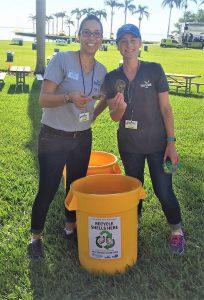When we think of recycling, we commonly think about plastic, glass, and aluminum products. What is not at the forefront of people’s minds is recycling the shells of the delicious oysters that they have just consumed during happy hour. Recycling oyster shells? This is a thing?
As it turns out, yes, it is a thing. Here in southeast Florida, this might be surprising since we do not have large oyster reefs in our bays and canals. The Eastern Oyster (Crassostrea virginica) is not found in southeast Florida because conditions aren’t right for them. The Eastern Oyster favors more temperate and estuarine environments, and here in Miami-Dade County, it’s just too consistently warm and salty for oysters. As residents, many of us delight in oysters as tasty treats at local seafood restaurants, and most often, when we’re done, we toss the shells into the trash without a second thought. However, those shells can be recycled and used to create new oyster reefs. While not common in southeast Florida, oyster shell recycling occurs throughout the Maryland/DC area, as well as the Gulf Coast and further north on the Atlantic Coast of Florida.
Oyster shell recycling programs are exactly what they sound like. After the meat is consumed, the empty shells are collected in special bins, transported to a central location, and laid to dry and cure in the sun for 3-6 months. Once these shells are thoroughly cleaned and dry, they are returned to the coast and installed in specific areas where they provide homes for baby oysters. These created or restored reefs serve multiple functions: they help protect the shoreline from strong wind and wave action, and, more importantly, they are the perfect habitat for baby oysters (spat) to settle on and grow! This practice helps sustain the oyster population for future generations. While there are many oyster reef restoration programs in the state, these programs are often shell-limited, since oysters harvested in one area are often consumed out of the region. Oyster shell recycling programs are a popular way to meet this demand for shell.
This March, myself andDr. Ashley Smyth of UF/IFAS TREC decided to test out a mini-oyster shell recycling program at the annual Deering Estate Seafood Festival. Special buckets were placed in strategic locations throughout the Festival and utilized volunteers to staff the stations, making sure that only oyster shells were placed inside. Additionally, Smyth and Zangroniz spoke with local seafood vendors and asked them to save the shucked shell for collection at the conclusion of the event. Both of these activities informed not only the vendors but also the consumers about the importance of shell recycling, and how by recycling their shells, participants would help contribute to the shell supply around the state.
At the end of the Deering Estate Seafood Festival, a total of 1,845 oyster shells (1,120 from vendors and 735 from consumers) were recycled. Shells are currently curing in the sun at TREC and will soon be transferred to restoration partners in need of shells. This was a great start to what is hoped will be a larger-scale, sustainable oyster shell recycling program. Given that one oyster reef section is about 20 feet long and usually requires 10,000 shells, the collection is about 20% of the way to a full reef! We are now working with local restaurants, restoration groups, and the public to investigate the development an oyster shell recycling program in Miami-Dade County. We plan to collect shell at the Coconut Grove Seafood Festival this October.

 0
0
